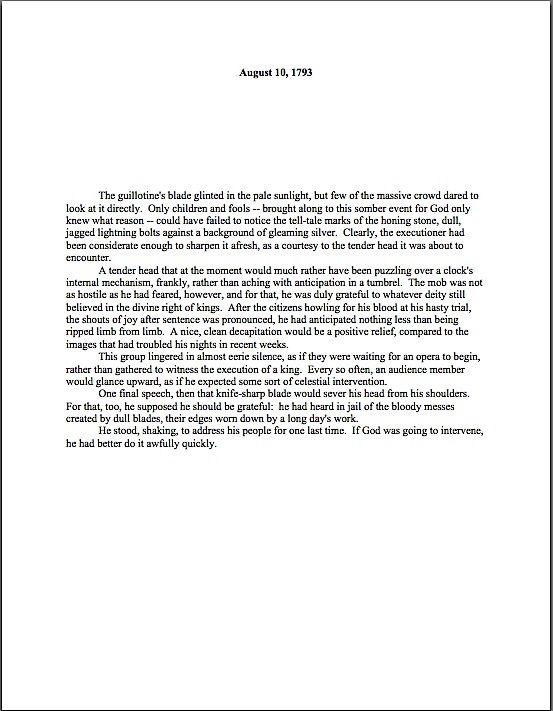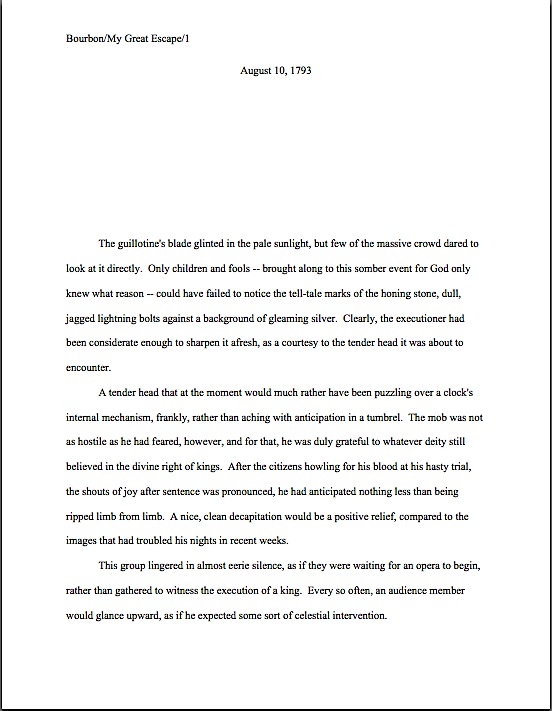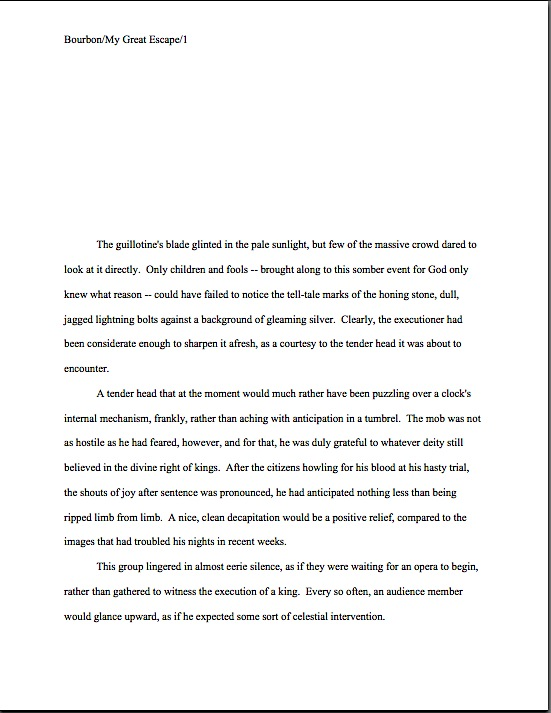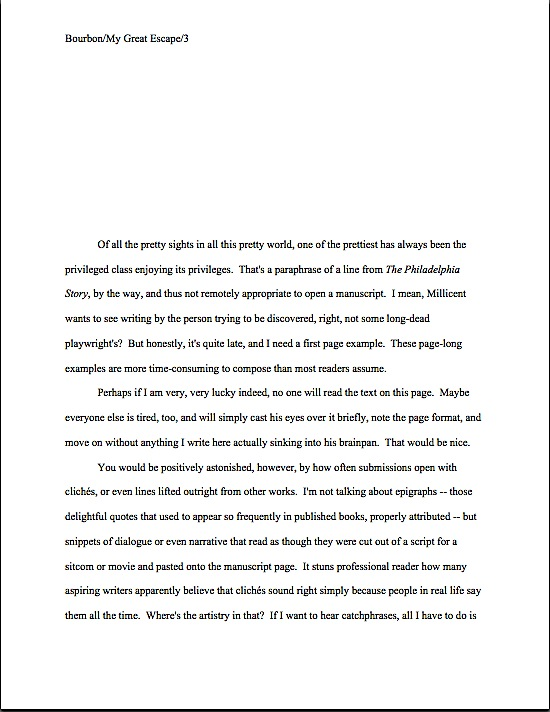It’s going to be a quick one this evening, I’m afraid, campers. Yes, yes, I know that I often say that, and then writing 14 pages because I discover that I have a lot to say on the topic at hand, but this time, I honestly am going to try to keep it short and sweet, in honor of my early day tomorrow.
Which may well be rescheduled, due to what looks to be about six inches of snow on the tree outside my studio window. Seattle does have a tendency to shut down on the first day of a snowstorm — and I tend to stay off the road running alongside my house when kids are sledding upon it. Call me zany.
What I am not calling zany is an interesting recent question from thoughtful reader Jen, zeroing in on a topic that even I can’t believe I’ve never addressed as a formatting issue before:
As you’re winding up Formatpalooza, I was wishing you would cover the question of how to format a teaser (as opposed to a prologue) at the beginning of a manuscript. Perhaps you have covered this in the past, but I can’t seem to find it. Thank you for your valuable help!
I’m delighted to help, Jen — but before I do, truth compels me to point out that the term teaser can refer to quite a few different things. Like so many writing terms, it can answer to one of several definitions with relation to novels, a couple of others with respect to nonfiction, a third set of things in journalism, and so forth. From the comparison to a prologue (as well as from some enlightening follow-up banter of the type that regularly goes on in the comments, thank goodness), the meaning in this case is a few pages — or even paragraphs — in the front of the manuscript that stand alone, rather than being related to the action on the first page of chapter 1.
In a published book, such an opening might appear like this, with Chapter One beginning on the next page:
Technically, an opening teaser like this is a prologue, whether or not it is labeled as such. In a published novel, it is virtually always treated like one: instead of being paginated with Roman numerals, as introductions in nonfiction books often are, an opening like this is almost invariably page 1 of a novel. The first page of Chapter One is simply numbered as the next page after the prologue.
The same logic prevails in a book manuscript intended for professional submission, whether it is fiction or nonfiction. (Academic texts work by different rules, though.) In standard format, the first page of text is page 1, always, regardless of how it would be numbered in a published book.
And why is that last caveat important to bear in mind, campers? Feel free to shout it along with me: professionally-formatted manuscripts differ in many respects from formatting in published books.
So how should the example above appear in a manuscript? It should be formatted precisely like a chapter opening — and like the first page of any manuscript. It should, in short, look like this:
But that doesn’t completely answer Jen’s question, does it? What should the first page of Chapter One look like, coming after such an opening? Glad you asked.
Is that a forest of hands that just sprouted out there, or is the snow doing something funny to my long-range vision? “But Anne,” some prologue-lovers shout, “isn’t that kind of opening likely to confuse Millicent the agency screener? I mean, isn’t she expecting the top of page 1 to be labeled Chapter One — and isn’t she likely to respond negatively if it isn’t? Shouldn’t I respond to my overpowering fear of her rejecting my manuscript on superficial grounds by labeling that opening as a prologue, so there is absolutely no chance of her being confused for so much as a nanosecond?”
Well, you certainly could do that, fearful tremblers, but it’s not strictly necessary. If you did, though, page 1 of your submission would look like this:
That makes abundant sense, right? Just as a chapter title would appear as a subtitle under the chapter designation, the prologue label would appear on the first line of the page, with the title of the prologue on the next double-spaced line. Everything else remains the same.
In a book category where such brief prologues are common openings, however, you don’t need to worry too much about Millicent’s not understanding what those first couple of pages are: trust me, she’ll recognize them. At least well enough not to be startled or confused when Chapter One opens in another time and place entirely — in this case, much earlier in poor Louis’ story.
Unless, of course, the writer chose to submit those pages like our next set of examples; see if you can spot the problem. Hint: if you jumped up from your desk chair, ran to the other side of the room, and squinted in the general direction of your computer screen, it would probably still be visible.
Did you catch the not-particularly-subtle problem here? Millicent might indeed find this opening confusing, because there’s nothing to indicate a time and place switch in the story. (Particularly unfortunate in this case, as the chapter is in a different voice than the prologue, and a rambling one at that.) Heck, there’s now nothing in the prologue section to indicate that it isn’t taking place in the present, rather than a couple of hundred years ago.
Chant it with me now, campers: when in doubt in a submission, opt for clarity, clarity, clarity.
Clarity, clarity, clarity is also why the prologue and/or introduction of a nonfiction manuscript (at least one not intended for an academic press) should follow the first page of text = page 1 rule. Yes, even if published books in your chosen book category always employ Roman numerals for prologues and introductions: trust me, if Millicent’s boss, the agent of your dreams, handles those sorts of books for a living, Millie will be able to figure out that the prologue that begins on page 1 of the manuscript will need to be repaginated by the editor.
Why am I so sure about that? Could it be because pagination decisions, like any other formatting calls in a published book, are the editor’s call, not the author’s?
Is everyone comfortable with all that? Please pipe up with questions, if not. And best of luck with the teasing, Jen!
Hmm, I could get used to writing posts this length. Or perhaps my will to communicate is just too strong. Keep up the good work!









Good question, Jen. I moved my prologue and it became part of a later chapter (made more sense that way), but that doesn’t mean I won’t have one in a future manuscript. Good to know how to set it up for Millicent’s discerning eye.
Love the post. Abundantly clear (three cheers for clarity, clarity, clarity), Anne! xoxoxo
Glad to help, Jen! Keep those good questions rolling in!